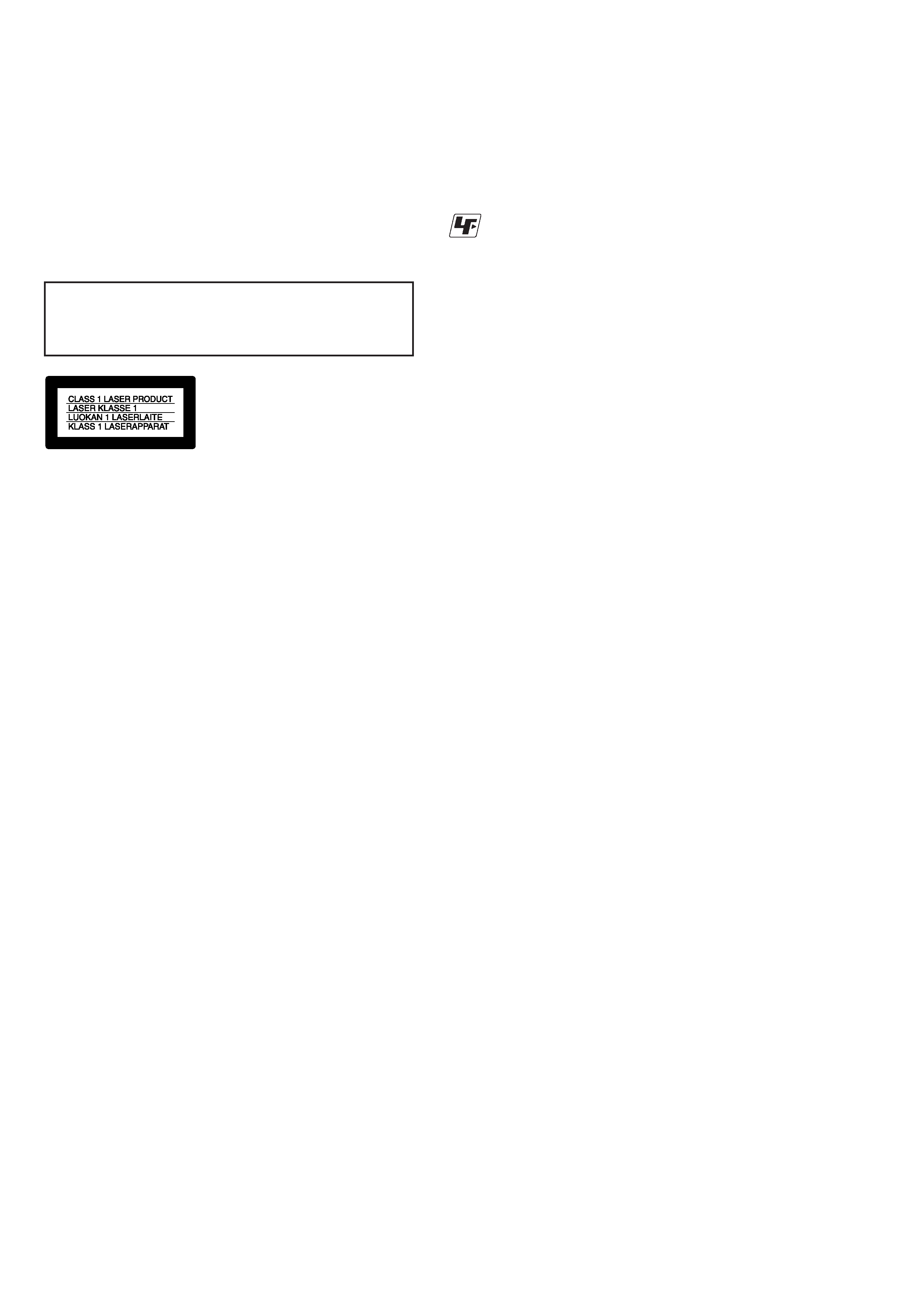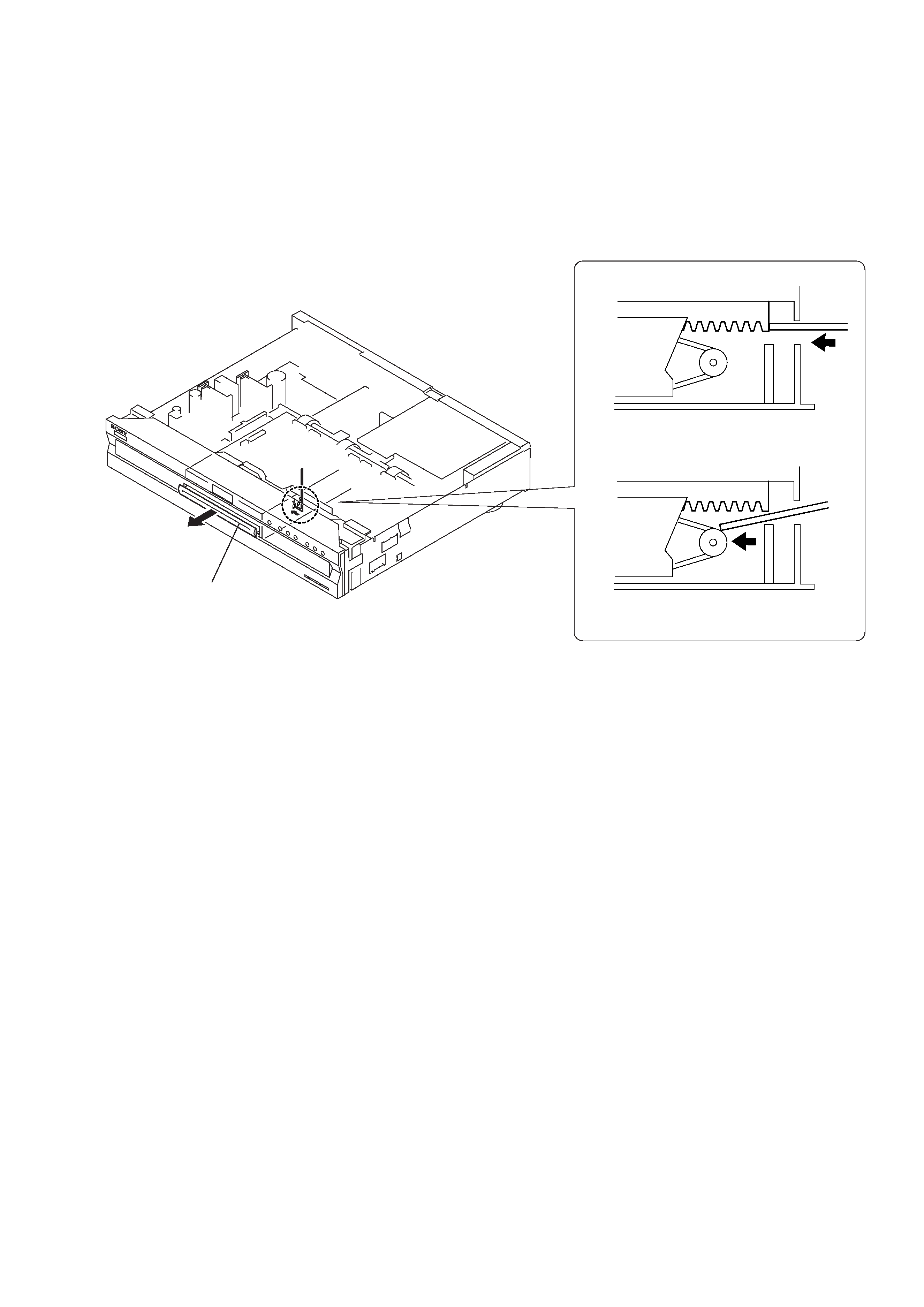
SERVICE MANUAL
DVD RECORDER
SPECIFICATIONS
RDR-GX7
RMT-D203P
AEP Model
UK Model
System
Laser
Semiconductor laser
Channel coverage
PAL/SECAM (B/G, D/K, I, L)
VHF: E2 to E12, R1 to R12, F1 to
F10, Italian A to H, Ireland A to J,
South Africa 4 to 13
UHF: E21 to E69, R21 to R69, B21
to B69, F21 to F69
CATV: S01 to S05, S1 to S20,
France B to Q
HYPER: S21 to S41
The above channel coverage merely
ensures the channel reception within
these ranges. It does not guarantee the
ability to receive signals in all
circumstances.
Video reception: Frequency synthesizer
system
Audio reception: Split carrier system
Aerial out
75-ohm asymmetrical aerial socket
Timer
Clock: Quartz locked
Timer indication: 24-hour cycle
(digital)
Power back-up duration: 1 hour
Video recording format
MPEG Video
Audio recording format/applicable bit
rate
Dolby Digital/2 ch, 256 kbps
Audio characteristics (Playback)
Frequency response
DVD (PCM 96 kHz): 4 Hz to 44 kHz
(
±1.0 dB)/DVD (PCM 48 kHz): 4 Hz
to 22 kHz (
±0.5 dB)/CD: 4 Hz to 20
kHz (
±0.5 dB)
Signal-to-noise ratio (S/N ratio)
DVD: 115 dB (LINE 2 OUT
(AUDIO L/R) jacks only)
Harmonic distortion
DVD: 0.002 %
Dynamic range
DVD: 110 dB/CD: 100 dB
Wow and flutter
DVD: Less than detected value
(0.001% W PEAK)
Audio characteristics (Recording/
Playback)
Frequency response
DVD (Dolby Digital 48 kHz):
10 Hz-20 kHz (
±1.0 dB)
Signal-to-noise ratio
DVD: 96 dB
Harmonic distortion
DVD: 0.004 %
Dynamic range
DVD: 96 dB
The signals from LINE 2 OUT (AUDIO
L/R) jack are measured. When you play
PCM sound tracks with a 96 kHz
sampling frequency, the output signals
from the DIGITAL OUT (OPTICAL or
COAXIAL) jack are converted to 48
kHz sampling frequency.
Inputs and outputs
LINE 2 OUT
(AUDIO)
Phono jack
Output level: 2 Vrms
Load impedance: 10 kilohms
(VIDEO)
Phono jack
Output level: 1.0 Vp-p
(S VIDEO)
4-pin mini DIN
Output level: Y:1.0 Vp-p, C: 0.3
Vp-p (PAL)
LINE 4 IN
(AUDIO)
Phono jack
Input level: 2 Vrms
Input impedance:
more than 22 kilohms
(VIDEO)
Phono jack
Input level: 1.0 Vp-p
(S VIDEO)
4-pin mini DIN
Input level: Y:1.0 Vp-p, C: 0.3 Vp-p
(PAL)
LINE 2 IN
(AUDIO)
Phono jack
Input level: 2 Vrms
Input impedance:
more than 22 kilohms
(VIDEO)
Phono jack
Input level: 1.0 Vp-p
(S VIDEO)
4-pin mini DIN
Input level: Y:1.0 Vp-p, C: 0.3 Vp-p
(PAL)
LINE 1 -TV
21-pin
CVBS IN/OUT
S-Video/RGB OUT (upstream)
LINE 3/DECODER
21-pin
CVBS IN/OUT
S-Video/RGB IN
S-Video OUT (downstream)
Decoder
DV IN
4-pin
i.LINK S100
DIGITAL OUT (OPTICAL)
Optical output jack
Output level: 18 dBm (wave
length: 660 nm)
DIGITAL OUT (COAXIAL)
Phono jack
Output level: 0.5 Vp-p
Load impedance: 75 ohms
COMPONENT VIDEO OUT(Y, CB, CR)
Phono jack
Output level: Y: 1.0 Vp-p/CB, CR: 0.7
Vp-p
General
Power requirements
220-240 V AC, 50/60 Hz
Power consumption
47 W
Dimensions (approx.)
430
× 89 × 381 mm (width/height/
depth) incl. projecting parts
Mass (approx.)
5.7 kg
Operating temperature
5 ºC to 35 ºC
Operating humidity
25 % to 80 %
Supplied accessories
Audio/video cord (1)
Mains lead (1)
Aerial cable (1)
Remote commander (remote) (1)
R6 (size AA) batteries (2)
Compatible colour systems
This recorder is designed to record using
the PAL colour system and play back
using the PAL or NTSC colour systems.
The signals of the SECAM colour
system can be received or recorded but
played back in the PAL colour system
only. Recording of video sources based
on other colour systems cannot be
guaranteed.
Specifications and design are subject to
change without notice.

-- 2 --
SAFETY-RELATED COMPONENT WARNING!!
COMPONENTS IDENTIFIED BY MARK 0 OR DOTTED LINE WITH
MARK 0 ON THE SCHEMATIC DIAGRAMS AND IN THE PARTS
LIST ARE CRITICAL TO SAFE OPERATION. REPLACE THESE
COMPONENTS WITH SONY PARTS WHOSE PART NUMBERS
APPEAR AS SHOWN IN THIS MANUAL OR IN SUPPLEMENTS
PUBLISHED BY SONY.
1.
Check the area of your repair for unsoldered or poorly-soldered
connections. Check the entire board surface for solder splashes
and bridges.
2.
Check the interboard wiring to ensure that no wires are
"pinched" or contact high-wattage resistors.
3.
Look for unauthorized replacement parts, particularly
transistors, that were installed during a previous repair. Point
them out to the customer and recommend their replacement.
4.
Look for parts which, through functioning, show obvious signs
of deterioration. Point them out to the customer and
recommend their replacement.
5.
Check the B+ voltage to see it is at the values specified.
6.
Flexible Circuit Board Repairing
· Keep the temperature of the soldering iron around 270°C
during repairing.
· Do not touch the soldering iron on the same conductor of the
circuit board (within 3 times).
· Be careful not to apply force on the conductor when soldering
or unsoldering.
SAFETY CHECK-OUT
After correcting the original service problem, perform the following
safety checks before releasing the set to the customer.
CAUTION
Use of controls or adjustments or performance of procedures
other than those specified herein may result in hazardous radiation
exposure.
WARNING!!
WHEN SERVICING, DO NOT APPROACH THE LASER EXIT WITH
THE EYE TOO CLOSELY. IN CASE IT IS NECESSARY TO
CONFIRM LASER BEAM EMISSION, BE SURE TO OBSERVE
FROM A DISTANCE OF MORE THAN 25 cm FROM THE SURFACE
OF THE OBJECTIVE LENS ON THE OPTICAL PICK-UP BLOCK.
CAUTION:
The use of optical instrument with this product will increase eye
hazard.
Unleaded solder
Boards requiring use of unleaded solder are printed with the lead-
free mark (LF) indicating the solder contains no lead.
(Caution: Some printed circuit boards may not come printed with
the lead free mark due to their particular size.)
: LEAD FREE MARK
Unleaded solder has the following characteristics.
· Unleaded solder melts at a temperature about 40°C higher than
ordinary solder.
Ordinary soldering irons can be used but the iron tip has to be
applied to the solder joint for a slightly longer time.
Soldering irons using a temperature regulator should be set to
about 350°C.
Caution: The printed pattern (copper foil) may peel away if the
heated tip is applied for too long, so be careful!
· Strong viscosity
Unleaded solder is more viscous (sticky, less prone to flow) than
ordinary solder so use caution not to let solder bridges occur such
as on IC pins, etc.
· Usable with ordinary solder
It is best to use only unleaded solder but unleaded solder may
also be added to ordinary solder.

-- 3 --
TABLE OF CONTENTS
SERVICE NOTE
1.
DISK REMOVAL PROCEDURE IF THE TRAY
CANNOT BE EJECTED (FORCED EJECTION) ············ 5
1.
GENERAL
1-1.
Operating Instructions ····················································· 1-1
WARNING ············································································ 1-1
Precautions ············································································· 1-1
Features ·················································································· 1-1
About This Manual ································································ 1-1
DVD Recorder Basics ···························································· 1-2
Guide to Parts and Controls ··················································· 1-2
Guide to Displays ·································································· 1-3
Recording/Timer Recording ······················································ 1-5
Before Recording ··································································· 1-5
Recording TV programmes ··················································· 1-5
Timer Recording ···································································· 1-6
Adjusting the Recording Picture Quality and Size ················ 1-7
Recording from External Equipment with a Timer
(Synchro Rec) ···································································· 1-7
Labelling, Protecting, or Finalizing the Disc ························· 1-8
Playback ···················································································· 1-9
Before Playing ······································································· 1-9
Playing Discs ········································································· 1-9
Selecting a Recorded Title on a Disc ··································· 1-10
Searching for a Title/Chapter/Track ···································· 1-10
Checking the Play Information and Playing Time ··············· 1-10
Selecting the Sound ····························································· 1-11
TV Virtual Surround Settings (TVS) ··································· 1-11
Changing the Angles ···························································· 1-11
Displaying the Subtitles ······················································· 1-11
Adjusting the Playback Picture and Sound ·························· 1-11
Editing a DVD ········································································· 1-12
Before Editing ······································································ 1-12
Basic Editing ········································································ 1-12
Advanced Editing (Playlist Edit) ········································· 1-13
Connecting a Digital Video Camera or Other Equipment ······· 1-14
Before Recording/Editing ···················································· 1-14
Recording an Entire DV/Digital8 Format Tape
(ONE TOUCH DUB) ······················································· 1-15
Program Edit ········································································ 1-15
Advanced Program Edit ······················································· 1-16
Re-editing the programs in the DV Edit List ······················· 1-16
Creating a Copy of the Edited Contents (Copy Dubbing) ··· 1-17
Recording From Equipment Connected to the LINE IN
Jacks ················································································· 1-17
Settings and Adjustments ························································ 1-18
About the Setup Display Structure ······································ 1-18
Using the Setup Displays ····················································· 1-18
Settings (Basic Settings) ······················································ 1-18
Video Settings ······································································ 1-19
Audio Settings ····································································· 1-19
Features Settings ·································································· 1-19
Options Settings ··································································· 1-20
Easy Setup (Resetting the Recorder) ··································· 1-20
Additional Information ···························································· 1-21
Troubleshooting ······································································· 1-21
Self-diagnosis Function (When letters/numbers appear in the
display) ···················································································· 1-22
1-2.
Hookups and Settings ···················································· 1-23
WARNING ·········································································· 1-23
Precautions ··········································································· 1-23
Basic Hookups and Settings ···················································· 1-23
Quick Overview ··································································· 1-23
Step 1: Unpacking ······························································· 1-23
Step 2: Connecting the Aerial Cable ···································· 1-23
Step 3: Connecting the Video Cords ···································· 1-23
Step 4: Connecting the Audio Cords ··································· 1-24
Step 5: Connecting the Mains Lead ····································· 1-25
Step 6: Preparing the Remote ·············································· 1-25
Step 7: Easy Setup ······························································· 1-25
Advanced Hookups and Settings ············································· 1-26
Setting the Clock ································································· 1-26
Presetting Channels ····························································· 1-26
Changing/Disabling the Channels ······································· 1-27
Controlling Your TV or AV Amplifier (Receiver) ················ 1-27
Connecting a VCR or Similar Recording Device to the
LINE3 Jack ·········································································· 1-28
Connecting to a Satellite or Digital Tuner ··························· 1-28
Connecting a PAY-TV/Canal Plus Decoder ························· 1-28
2.
DISASSEMBLY
2-1.
TOP CASE ······································································ 2-2
2-2.
ER-020 BOARD ······························································ 2-2
2-3.
POWER BLOCK ····························································· 2-3
2-4.
D. C. FAN ········································································ 2-3
2-5.
REAR PANEL ································································· 2-4
2-6.
TRAY COVER ASSEMBLY ·········································· 2-4
2-7.
FRONT PANEL SECTION ············································· 2-5
2-8.
ALUMINUM DOOR, DOOR BASE ······························ 2-5
2-9.
SHAFT (R) ······································································ 2-6
2-10. RD-045 BOARD ····························································· 2-7
2-11. FL-130 BOARD ······························································ 2-8
2-12. FR-195 BOARD ······························································ 2-8
2-13. TX-001 BOARD ····························································· 2-9
2-14. DVD DRIVE ··································································· 2-9
2-15. AV-071 BOARD ···························································· 2-10
2-16. CIRCUIT BOARDS LOCATION ································· 2-11
3.
BLOCK DIAGRAMS
3-1.
OVERALL BLOCK DIAGRAM (1/2) ··························· 3-1
3-2.
OVERALL BLOCK DIAGRAM (2/2) ··························· 3-3
4.
PRINTED WIRING BOARDS AND
SCHEMATIC DIAGRAMS
4-1.
FRAME SCHEMATIC DIAGRAM (1/2) ······················· 4-1
4-2.
FRAME SCHEMATIC DIAGRAM (2/2) ······················· 4-3
4-3.
PRINTED WIRING BOARDS AND
SCHEMATIC DIAGRAMS ············································ 4-5
WAVEFORMS ································································ 4-6
· AV-071 (TUNER, VIDEO IN PROCESS, RD I/F, AV IN/
OUT, AUDIO IN/OUT UV IC, SYSTEM CONTROL,
PDC, POWER)
PRINTED WIRING BOARD ························· 4-7
· AV-071 (1/10) (VHF/UHF TUNER)
SCHEMATIC DIAGRAM ···························· 4-11
· AV-071 (2/10) (VIDEO IN PROCESS)
SCHEMATIC DIAGRAM ···························· 4-13
· AV-071 (3/10) (RD I/F)
SCHEMATIC DIAGRAM ···························· 4-15
· AV-071 (4/10) (A/V IN/OUT TERMINAL)
SCHEMATIC DIAGRAM ···························· 4-17
· AV-071 (5/10) (AUDIO IN)
SCHEMATIC DIAGRAM ···························· 4-19
· AV-071 (6/10) (AUDIO OUT)
SCHEMATIC DIAGRAM ···························· 4-21
· AV-071 (7/10) (UV IC)
SCHEMATIC DIAGRAM ···························· 4-23
· AV-071 (8/10) (SYSTEM CONTROL)
SCHEMATIC DIAGRAM ···························· 4-25
· AV-071 (9/10) (3D)
SCHEMATIC DIAGRAM ···························· 4-27
· AV-071 (10/10) (POWER)
SCHEMATIC DIAGRAM ···························· 4-29

-- 4 --
· FL-130 (FL DRIVE)
PRINTED WIRING BOARD ······················· 4-31
· FL-130 (FL DRIVE)
SCHEMATIC DIAGRAM ···························· 4-33
· FR-195 (SWITCH, LED)
PRINTED WIRING BOARD ······················· 4-35
· FR-195 (SWITCH, LED)
SCHEMATIC DIAGRAM ···························· 4-39
· CN-177 (CONNECTOR)
PRINTED WIRING BOARD ······················· 4-41
· CN-177 (CONNECTOR)
SCHEMATIC DIAGRAM ···························· 4-42
· ER-020 (LINE1/LINE3 EURO CONNECTOR)
PRINTED WIRING BOARD ······················· 4-43
· ER-020 (1/2) (LINE1 EURO CONNECTOR)
SCHEMATIC DIAGRAM ···························· 4-47
· ER-020 (2/2) (LINE3 EURO CONNECTOR)
SCHEMATIC DIAGRAM ···························· 4-49
· TX-001 (TELTEXT)
PRINTED WIRING BOARD ······················· 4-51
· TX-001 (TELTEXT)
SCHEMATIC DIAGRAM ···························· 4-53
· POWER (POWER SUPPLY BLOCK)
PRINTED WIRING BOARD ······················· 4-55
· POWER (POWER SUPPLY BLOCK)
SCHEMATIC DIAGRAM ···························· 4-57
5.
IC PIN FUNCTION DESCRIPTION
5-1.
IT CONTROL IC (IC605:
µPD703033BYGF-M29-3BA-A
(AV-071 BOARD)) ·························································· 5-1
6.
SERVICE MODE
6-1.
Device relation diagram.
Display data (for your reference to check the signal path) ·· 6-1
6-2.
Block diagram
(for your reference to check the devices) ······················· 6-2
6-3.
Screen Transition in the Service Mode ···························· 6-2
6-4.
Service Mode. Menu Items and Description ··················· 6-3
6-5.
Device Check Menu (1/2) ··············································· 6-3
6-6.
Device Check Menu (2/2) ··············································· 6-3
6-7.
Path Check Menu (1/2) ···················································· 6-4
6-8.
Path Check Menu (2/2) ···················································· 6-4
6-9.
Device All Check. Screen Transition ······························· 6-5
6-10. Device Individual Check. Screen Transition ··················· 6-5
6-11. Path Individual Check (Pasted Screen Check).
Screen Transition ····························································· 6-6
6-12. Path Individual Check (Data Check Confirmation).
Screen Transition ····························································· 6-6
7.
ADJUSTMENT
7-1.
VIDEO SYSTEM ADJUSTMENT ································· 7-1
1.
Video Level Adjustment (RD-045 Board) ······················· 7-1
2.
Component Video Output Level Adjustment
(RD-045 board) ······························································· 7-1
3.
S-Video Output S-Y Level Check ··································· 7-1
4.
S-Video Output S-C Check ············································· 7-1
5.
Component Video Output Y Check ································· 7-2
6.
Component Video Output B-Y Check ····························· 7-2
7.
Component Video Output R-Y Check ····························· 7-2
8.
REPAIR PARTS LIST
8-1.
EXPLODED VIEWS
8-1-1. OVERALL ······································································ 8-1
8-1-2. FRONT PANEL SECTION ············································· 8-2
8-1-3. CHASSIS SECTION ······················································· 8-3
8-2.
ELECTRICAL PARTS LIST ·········································· 8-4

-- 5 --
SERVICE NOTE
1. DISK REMOVAL PROCEDURE IF THE TRAY CANNOT BE EJECTED (FORCED EJECTION)
1.
Pull out the power cord.
2.
Remove the top case.
3.
Prepare a hexagonal wrench or L-shaped stiff wire. (See Fig.1-1)
4.
Insert a hexagonal wrench (or hard wire) into a hole on the side of the DVD drive in the right angle. (See Fig. 1-1. and 1-2.)
Note: If a hexagonal wrench (or hard wire) is not inserted in at the right angle, belt may be damaged.
5.
Press the rack to open the tray a little.
6.
Pull out the tray slowly and gently.
NOTES DURING THE FORCED EJECTION
1. If the forced ejection is executed while a blank disc media (DVD±RW, ±R) exists on the tray
· Insert a DVD-ROM (DVD test disc, DVD software available on the market, or the like) in the tray and then close the tray.
Note1: If you close the tray while it is empty, ejection of the tray becomes impossible.
Note2: If you close the tray with a CD disc inserted in it, the CD can be ejected. However, if you close the tray while it is empty, there can be a case that
ejection of the tray becomes impossible.
Note3: Even if you replace the DVD drive unit while the tray remains under the state as described above, the situation cannot be improved.
2. If the tray cannot be ejected while the disc is not inserted
· Execute the forced ejection.
· Insert a DVD-ROM (DVD test disc, DVD software available on the market, or the like) on the tray and try to close the tray.
(There are cases that it recovers the trouble.)
3. Contents of forcedly ejected blank disc media (DVD±RW, ±R) can be damaged. (There can be a case that initialization is also impossible.)
Tray
Right way of pushing the wrench
Wrong way of pushing the wrench
Fig. 1-1
Fig. 1-2
